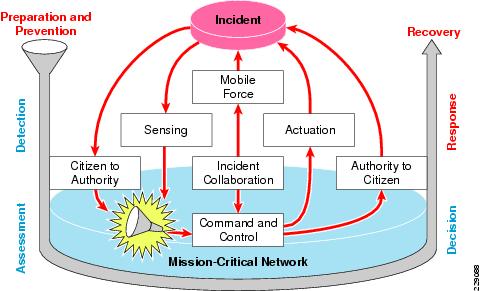

Table Of Contents
Architecture Framework
The Cisco Open Platform for Safety and Security (Cisco-OPSS) is an architecture framework that technology architects can use to develop solutions for Urban Security. The framework offers public safety officials the flexibility to adopt new technology to meet evolving operational requirements, including real-time decision-making and networked command and control.
Cisco-OPSS consists of the following six major architecture building blocks as shown in Figure 2-1.
•
Command and Control
•
Mission-Critical Networks
•
Incident Collaboration
•
Sensing and Actuation
•
Mobile Force
•
Citizen-Authority Interaction
Figure 2-1 Cisco Open Platform for Safety and Security
Each architecture building block contains an hierarchy of functional building blocks. In combination, these building blocks provide a rich set of capabilities to support a particular organization's safety and security goals.
For this release of the Urban Security Design Guide, the focus is limited to the following three architecture building blocks of the COPSS architecture:
•
Command and Control
•
Sensing and Actuation
•
Citizen-Authority Interaction
Future releases of this design guide will expand on the concept and address the rest of the architecture building blocks not included in this release.
Cisco and its partners defined functional building blocks logically, rather than specifying a particular product offering. This gives organizations the flexibility to select various solutions based on their country and individual requirements. It also makes it easier to identify any missing capabilities in a specific solution.
The following sections provide brief descriptions of each of the six architecture building blocks of the Cisco Open Platform for Safety and Security.
Command and Control
Command and Control provides the emergency management team with up-to-date situational awareness, actionable intelligence, and decision support tools. Command and control contains the following functional building blocks:
•
Common Operational Picture (COP)
•
Unified Management
•
Simulation and Investigation
Sensing and Actuation
The Sensing and Actuation building block streams information from the incident scene to the operations center and provides the means for swift and automated remote action. It contains the following functional building blocks:
•
Quantitative sensors
•
Qualitative sensors
•
Human identification based on physical characteristics that are part of a system (biometrics, as opposed to video analytics, where no specific identification is made)
•
Object identification, possibly including RFID
•
Real-time video analytics
•
Sensor correlation and baselining
•
Actuators
•
Legacy integration
Citizen-Authority Interaction
The Citizen-Authority Interaction building block provides two-way communications capabilities. Service codes, also known as N11 codes, are used to provide three-digit dialing access to special emergency support services. Examples of these numbers include 112, 911, or 999. Conversely, authorities can alert a specific group of individuals about immediate danger, such as a fire, bomb, or biological attack. This capability is sometimes called Reverse 911.
The Citizen-Authority Interaction contains the following functional building blocks:
•
Authority-to-Citizen—Public alert notification and information systems
•
Citizen-to-Authority—Public Safety Answering Point (PSAP)
Mission-Critical Network
Public safety and security organizations today rely on a variety of heterogeneous networks to carry out all their activities. Consolidating these networks into a unified Emergency-Grade Network platform optimizes emergency operations. The Emergency-Grade Network must be scalable, resilient, secure, and intelligent.
The Mission-Critical Network functional building blocks include the following:
•
IP-layer abstraction
•
Traffic optimization, including quality-of-service (QoS), resilience, multicast, and traffic engineering
•
Self-defense, including network access control, VPN, and firewall
•
Mobility, including wireless access and geolocation
•
Data center technologies, including high-performance computing, WAN acceleration, and load balancing
•
Rapid deployment
The Mission-Critical Network uses IP to support multiple transmission standards, including Terrestrial Trunk Radio (TETRA), WiMax, Wi-Fi, 3G, and satellite communication technologies.
Incident Collaboration
The effectiveness of communications between first responders and the command and control center can have life-or-death consequences. The Incident Collaboration building block helps to ensure that teams can communicate using any available technology, including IP and analog or digital radio, as well as any media, including voice, video, instant message (IM) or short message service (SMS), and data. Incident Collaboration contains the following functional building blocks:
•
Core systems, which include call processing, user and device provisioning, communication provisioning, monitoring, interoperability and open interfaces, system recovery, security management, presence services, and gateways
•
User terminal, which can be defined in terms of its connectivity and functionality
•
Notification services, which include instant messaging, SMS, E-mail, and paging
•
Conferencing, which includes data sharing, voice, video, and Cisco TelePresence
Emergency responders must be able to spontaneously create communications groups that link people in a geographical area, regardless of their organization or the communication device they use.
Mobile Force
The Mobile Force building block ensures that human resources are as effective in the field as they are in the central monitoring room. The following are some examples:
•
Security guards can monitor and control video surveillance cameras from a hand-held device.
•
Police officers in their vehicles can securely access central databases through a mobile access router.
•
Fire commanders can monitor conditions at the scene through the biosensors on firefighters' suits.
•
First responders can receive events with visual verification to determine validity of event and severity of the threat level.
•
On the way to a disaster scene, rescue teams can receive up-to-the-minute information such as location, type of accident, and casualties.
•
Emergency services personnel receive appropriate information based on their role, access information using a graphical, intuitive interface, and can use it to rapidly decide on the best operational tactic.
The Mobile Force architecture building block contains the following functional building blocks:
•
Mobile devices—Personal passive devices, personal computing devices, and vehicle computing devices
•
Mobility types—Nomadic, seamless, and adhoc
•
User-based services—Location-based services, application and databases access, automatic alerting and notification, zero-touch configuration and management, and a communications and collaboration interface.

